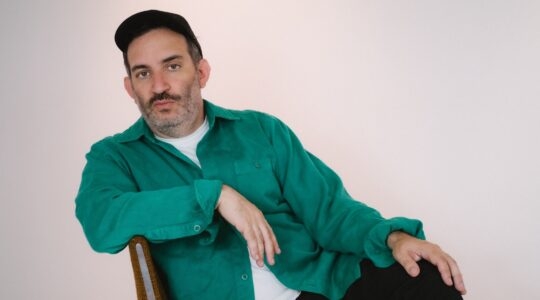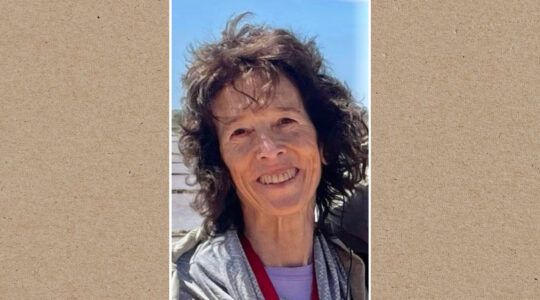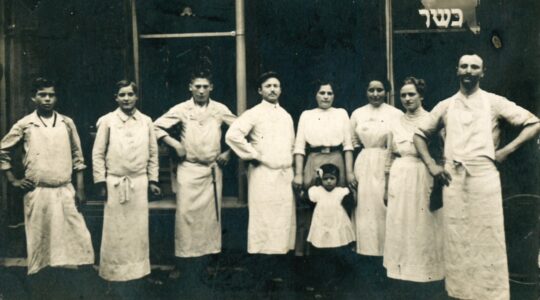Sherman Jackson, a black convert to Islam and a professor of Islamic studies at the University of Michigan, says exposing his children to practicing Jews is bound to increase their own devotion to Muslim tradition.
“My children are likely to draw inspiration from seeing other, Jewish, children serious about their religion,” Jackson told an audience of about 700 people Monday night during a panel discussion at the Jewish Theological Seminary. Likewise, he said in an interview later, “a practicing Muslim can be a source of inspiration for Jews to practice their own religion.
Jackson’s words captured the atmosphere at this week’s event, which focused on the status of Judaism and Islam as minority faiths in this country and what they could learn from each other’s experience. The discussion, which drew a mixed crowd of Jews, Muslims and Christians, took place amid two days of closed workshops on those subjects involving scholars, leaders and clerics of all three faiths.
The event also took place in the midst of what one participant called a “bad time” for American Muslims linked, in part, to the controversy over the proposed Islamic center and mosque near Ground Zero, also referred to as Park51. Plans for the center have become the target of protest and heated rhetoric as some Americans try to discredit the Islamic faith or blame all Muslims for 9/11.
Those attitudes are found not only among Americans in general, but in the Jewish community, and can easily create an obstacle to dialogue. So, too, can attitudes within the Muslim community, as discussed in New York earlier this month at a conference sponsored by the Journal for the Study of Antisemitism.
One speaker at the conference, Sam Edelman of Scholars for Peace in the Middle East, told the Jewish Week that he and others who have been involved in Jewish-Muslim dialogue had been “burned” in the past by Muslim participants who later made radical statements, making them reluctant to join such efforts.
Indeed, before Monday’s event, JTS leaders received a “handful” of letters and emails critical of their plans, said Eve Glasberg, the school’s assistant director of communications. The correspondence came from outside JTS, which is the Conservative movement’s flagship institution.
Jewish and Muslim participants in the dialogue discussed some of the obstacles during their workshops, said Rabbi Burt Visotzky, an organizer of the event and the school’s professor of Midrash and interreligious studies.
“We’re both acutely aware that each community” has its share of members with hateful or bigoted views, he said.
But Arnold Eisen, chancellor of JTS, said everyone involved in the two-day event wanted to explore “the big picture” — namely, “how various faiths in this country can live together, can retain their own authenticity and can agree to differ while learning from those differences and what we share.”
Like Rabbi Visotzky, Eisen, one of Monday night’s four panelists, acknowledged the tensions but brushed them aside. “We have to present a different model to the world,” he said.
In addition to Eisen, the panel included Jackson; Serene Jones, president of Union Theological Seminary, a mainline Protestant institution within a block of JTS; and the event’s moderator, Ingrid Mattson of the Hartford Seminary, where she directs a center for the study of Islam and Christian-Muslim relations. Mattson is also immediate past president of the Islamic Society of North America.
Support the New York Jewish Week
Our nonprofit newsroom depends on readers like you. Make a donation now to support independent Jewish journalism in New York.
Speaking first Monday night, Eisen talked of his great love for Jewish scripture and of his desire “to be consistent” with what it says.
“I hang on for dear life to this text,” even as he and other Jews change, he said, adding that he’d be “lost” if he let it go. The question, though, is how Jews can find the balance between integration into the American community and survival. “Where is the tipping point?” he asked.
The other question Eisen posed is whether religious pluralism can be compatible with religious commitment — the answer of which is key to interfaith dialogue. The chancellor’s own answer is that the two can be compatible, but that the case for pluralism has to come from within the faith or, as he expressed it, “grounded in the covenant.”
Jackson offered a similar response, saying that “this kind of cooperation and exchange is an authentic part of the Muslim tradition.” But he said the notion of assimilation is a problematic one for American Muslims, a third of whom are black converts and two-thirds of whom are immigrant Muslims and white converts. Black Muslims, for instance, associate “assimilation” with the concept of “Uncle Tom,” he said, while immigrant Muslims believe it’s tantamount to “ingratiating” themselves with the dominant culture, something they connect to “capitulation.”
For her part, Jones, added to the panel to provide a Christian perspective, also added some levity to the evening.
To approach the questions of assimilation and authenticity “from where I sit,” she said, is to approach them “from the belly of the beast,” the most assimilated group in America. Still she added, Christians are facing their own set of challenges, including the disappearance of many churches. Another challenge — and one that pains her personally — is that some, in her eyes, are using Reformed Christianity to promote an agenda of “cruelty” and “exclusion.”
In a dialogue that often seemed riveting, the panel’s Jewish and Muslim members also discussed the importance of having allies.
Jackson, meanwhile, said the Jewish community “could be a very important ally in simply allowing for a space in which Muslims can speak by recognizing that the same voices that would shut Muslims down could also shut Jews and other minorities down.”
He also spoke of what he called “the power of the margin” — the idea that, in the fragmented quilt of groups that now represents America, each community has a certain power, along with the responsibilities that that power carries. In that context, he added, Jews and Muslims could achieve more together, especially when it comes to challenging “the middle’s monopoly over the definition of America,” that either group could on its own.
The workshops preceding and following the panel discussion explored a number of broad themes, including the common history that unites American Jews and American Muslims, how both faiths share a scriptural interpretation and how that’s changed as a result of their American experience, Rabbi Visotzky said.
The one issue they didn’t discuss was the Middle East, a subject on which “everyone knew there would be differences,” the rabbi said. Everyone hopes for peace, he said, but a discussion of “who we root for and the sides we take” would obviously have been “fractious.”
Meanwhile, critics of Jewish-Muslim dialogue might take issue with ISNA, the group Mattson led, as they have in the past. One thing they’ve pointed to is the group’s past links to Islamic radicals, including supporters of Hamas. But the group has been involved in a far-reaching dialogue with the Union for Reform Judaism and has changed considerably in the last few decades, according to URJ’s president, Rabbi Eric Yoffie. He said ISNA has denounced terrorism — an observation also made by Abraham Foxman, national director of the Anti-Defamation League — and has called for peace in the Middle East based on a two-state solution.
Support the New York Jewish Week
Our nonprofit newsroom depends on readers like you. Make a donation now to support independent Jewish journalism in New York.
Mattson, who recently served two terms as ISNA’s president, has called on fellow Muslims to break their ties with extremists.
“It’s much more difficult in the public sphere, where all sorts of emotional levers are being pulled and where “the predominant emotions are fear and distrust,” she added. “It’s almost impossible to have a reasonable conversation where people can learn anything, because they’re in an emotionally reactive state rather than a receptive state.”
The New York Jewish Week brings you the stories behind the headlines, keeping you connected to Jewish life in New York. Help sustain the reporting you trust by donating today.




